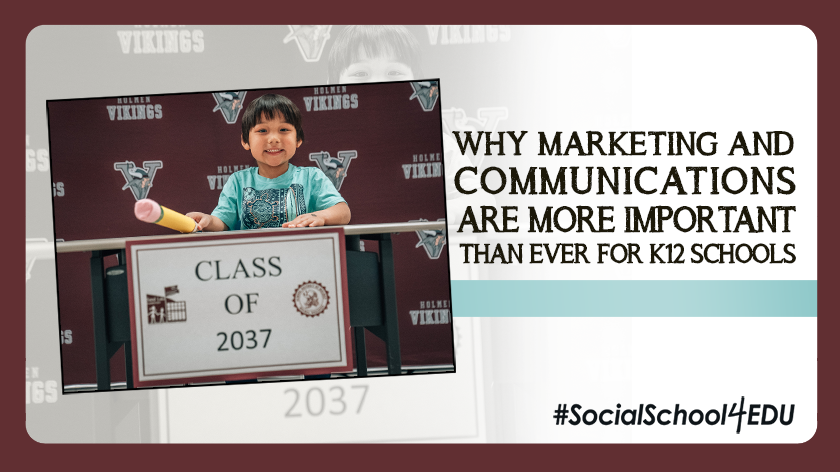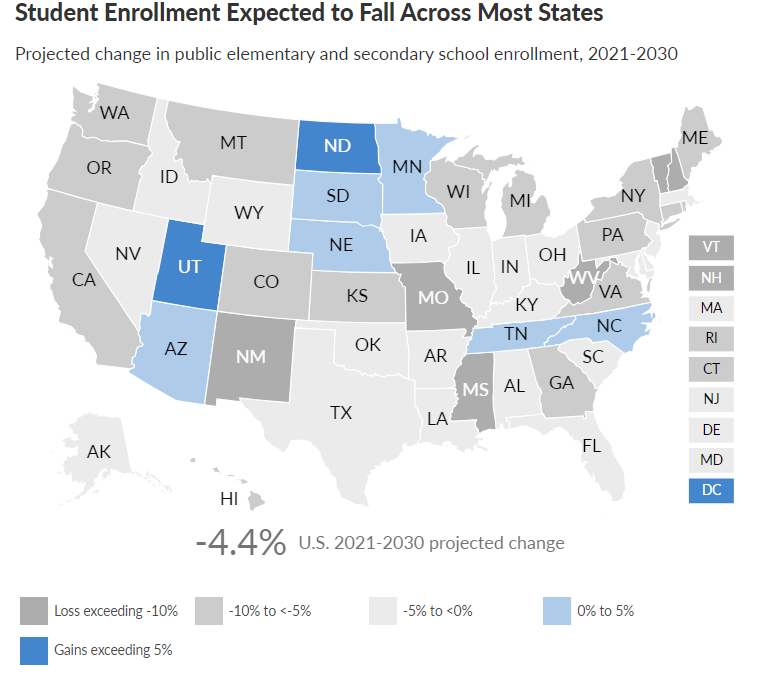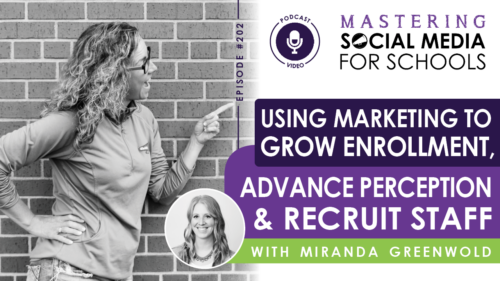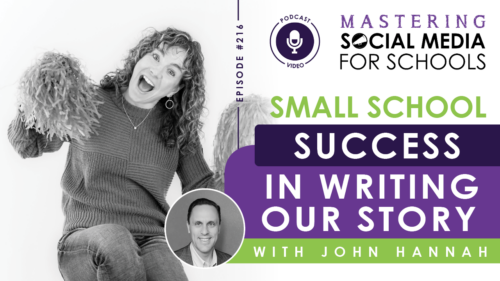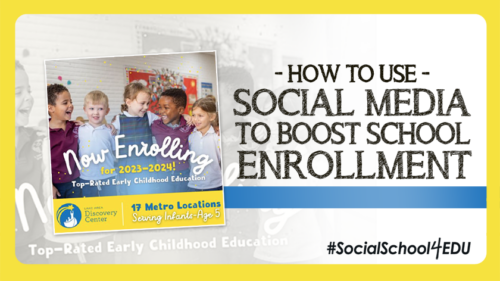School communicators should have the most secure jobs in education. Your role is foundational to the very survival of your institution, no matter if you’re working for a public, private, or charter school.
Why?
The pandemic completely upended the education system. Enrollment trends, parent expectations, and even birth rates have shifted how schools market themselves and communicate to current and prospective families. Unless you’ve been living under a rock, you have experienced this firsthand.
Yet I’m alarmed to hear how many schools are slashing budgets by starting with marketing and communications funds!!
While it might be necessary to tighten budgetary belts as educational funding sources dry up (more on that in a moment), taking away resources from marketing/communications is counterintuitive to your goals.
Allow me to make the case for why marketing and communications are more important than ever for K12 schools. By the end of this blog, you’ll not only be convinced of the need for dedicated resources for marketing/communications, but you’ll also have some actionable tips for cost-effectively supporting your school’s outreach goals!
Funding and Enrollment Challenges
Depending on the funding formula for your district, your state, county, and/or city provides more dollars for every student that you enroll. That gives you an indisputable incentive to prioritize funds for communications and marketing! These invested dollars can potentially provide exponential returns, because every additional student could mean $10,000+ in funding.
Bob Noyed, APR, Vice President of CESO Communications says it best:
The choice to market your schools has disappeared. Effective marketing and reputation management strategies are now essential to survive in the competitive marketplace. As an example, what if you started by reserving $10 per student to build your marketing budget? In a district with 2,500 students, that’s $25,000 – enough to create and implement a marketing strategy. And let’s take it one more step – let’s say your $25,000 investment in marketing resulted in a boost in enrollment of 25 students. Assuming each student yields $10,000 in revenue, you brought in $250,000 to your district by investing $25,000 – your return on investment into effective marketing can make a huge difference.
But we know that money isn’t always readily available. Some of the critical financial obstacles that school leaders are facing include:
ESSER Funds Expiring
EducationWeek reports that as the expiration date for the Elementary and Secondary School Emergency Relief (ESSER) funds approaches, school districts face the significant challenge of addressing budget shortfalls. These funds, which were part of the federal support during the COVID-19 pandemic, have been instrumental in financing additional staff, new programs, and facility renovations.
School districts have until the end of September 2024 to commit their funds and must spend that money within four months.
Declining Birth Rates
On average, families today choose to have fewer children, leading to a nationwide decline in birth rates. Naturally, this affects how many kids need our education system.
According to the Pew Research Center, “Recent projections published by the National Center for Education Statistics show total U.S. public elementary and secondary school enrollment will fall 4.4% from 2021 to 2030, partially because of lower fertility. States with the top projected public school enrollment declines include West Virginia (-19.9%), Mississippi (-17.5%), New Mexico (-16.8%), New Hampshire (-14.9%), and Vermont (-11.2%)… Falling enrollment means that school districts will receive less money from the federal and state governments. Although having fewer students will also lower some costs, many of a school district’s expenses are fixed—so funding cuts resulting from enrollment declines could pose financial hurdles.”
Alternative Educational Options
At #SocialSchool4EDU, we proudly help schools of any size, shape, or structure. That includes public, private, charter, and everything in between. I truly believe that there is a place for every school in the “market” of education – but I am also mindful that this plethora of choices presents challenges for school leaders.
To put it bluntly, the school or district next door is your direct competition! Open enrollment has also given families more options, even between neighboring public school districts.
This article from District Administration highlights how the pandemic accelerated and exacerbated this dynamic. Many parents became deeply dissatisfied with their children’s schools during the pandemic, prompting them to explore alternative education options like charter schools, private schools, and homeschooling.
In extreme cases, the school enrollment decline is leading to building closures within districts.
You Can’t Afford NOT to Invest in Marketing/Communications!
Whew, that was heavy! I know this article hasn’t been all sunshine and rainbows so far, but there’s just such a need for marketing and communications budgets in K12 schools.
If you’re reading this and feel like your school needs to step up, I’ve got good news: We’ll discuss some actionable tips next!
Step 1: Create a Marketing/Communications Strategy
The best place to start is with a marketing plan. According to Miranda Greenwold, Chief Growth Officer for Marketing Matters, a school marketing plan should always start with your target audience in mind. Then, you can create a thoughtful strategy and design marketing tactics (such as social media) to support those goals.
We talked all about this in a podcast interview; listen here:
Next, educate yourself on how families make education decisions for their kids!
Niche compiles annual data from families across the country. The company’s most recent survey (2023) revealed the following findings (read all the data for yourself, here!):
- Sixty-two percent said parents of students currently enrolled at the schools they considered influenced their decisions.
- Fifty-three percent (a 3% increase from 2022) said parent feedback in social media groups, blogs or online forums influenced their decisions.
- Facebook groups were the most influential social media channel, followed by organic Facebook posts (26%), Instagram (22%) and YouTube (9%).
- The most influential social media channels for prospective students were Instagram (25%), Facebook (13%), YouTube (12%) and TikTok (12%).
- Their preferred online research tools for comparing schools were school search and review platforms (79%), Google reviews (42%), Google search (41%) and Facebook groups (21%).
- Nearly 30% of parents attended an enrollment event on campus as the first step they took to engage with the schools they considered for their children.
This data should influence your marketing/communications plan and help you make the case for directing budget dollars in ways that make the most sense for your audience and community.
Step 2: Embrace Social Media as a Cost-Effective Tool
Of course, social media is not the only marketing tactic at your disposal. Savvy schools invest in great websites, paid advertising, ongoing community engagement strategies, and much more.
But social media is a pivotal tool in your Communications Toolbox, used to reach thousands of people. Here are four ways to take full advantage of social media for your school:
- Celebration > Information: Shift from using social media for announcements to sharing meaningful stories highlighting the school’s culture, achievements, and community impact. Focus on celebration over information (80/20) to maximize your potential for reach and engagement on social media!
- Mobilize Stakeholders: Your biggest fans are already within your district! Get families and staff members involved, telling them how important it is to interact, share, and comment on your social media posts.
- Word-of-Mouth Marketing: Word of mouth is still the strongest form of marketing – but it looks different in 2024. See the above-listed data from Niche! Word of mouth happens on social media platforms. Give people something positive to talk about! Their comments and shares on your content will help expand your school’s reach.
- Dedicated Personnel: I’ve been doing this for ten years, and if there’s one thing I’ve learned, it’s that the only way to truly be effective on social media is if you have a dedicated staff member (or consultant) managing your presence. If it’s everyone’s job, it’s NO one’s job. You need someone on board to professionally manage and enhance your school’s online presence.
But what if you’re a small school district and can’t justify hiring full-time school communication staff?
Don’t be discouraged; you can still take advantage of the power of social media.
Case in point? I recently had an excellent conversation with John Hannah, Superintendent for Morton School District in Washington, all about how his small district is enrolling more students thanks to social media. This episode is a must-listen if you are in a district with fewer than 3,000 students.
Step 3: Use These Six Social Media Post Ideas to Increase Enrollment
Ready for even more tactical tips? I wrote this blog a year ago to highlight the role of social media in meeting school enrollment goals. It includes six post ideas (with examples!!) to support your marketing efforts. Take a look:
If you love actionable ideas like the ones shared in this blog and want to be inspired by what’s working for other schools to increase enrollment, my membership program is the spot for you! We train your staff to be social media storytellers so you can stand out from other schools, celebrate your students and staff, and reach thousands in your community every day. Learn more.
Making Marketing/Communications a Priority
Marketing and communications budgets are no longer just “nice to have” line items; they are essential to your school’s survival in today’s educational environment. To keep enrollment healthy, every school must articulate its unique value to parents and the community.
By investing in strategic marketing and communications, schools can retain current students and attract new ones, securing much-needed funding that directly impacts the quality of education provided! It’s all about the kids. And now that you know social media is an important piece of that puzzle, I’m here to help you every step of the way.

